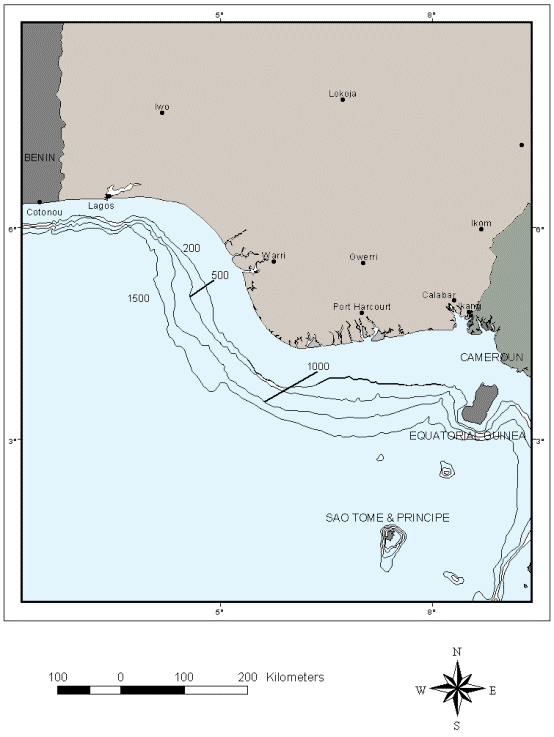
|
Nigeria lies between Lat. 4° 16' -13° 52 'N and Long. 2° 49' -14° 37' E and has a coastline of about 850 km which borders the Atlantic Ocean in the Gulf of Guinea. The limits of Nigeria's territorial waters and Exclusive Economic Zone (EEZ) are 12 nml and 200 nml respectively (i.e. 22 224 km and 370.40 km). The total area of the continental shelf is approximately 41 000 km² (Doy2859e, 1980) but the flats are interrupted coast-wide by unburied fossil corals at about ~40-120 m depth (Allen and Wells, 1962; Awosika, 1990); Canyons off Lagos, Mahin and Calabar also interrupt the shelf (Allen, 1964). Apart from these interruptions and some off shore oil prospecting installations, which now constitute a kind of obstacle for trawling, but sanctuaries for some finfish resources, the shelf is considerably trawlable. Table 1 below indicates the extent of the continental shelf off East of Lagos to between Kwa Iboe and Cross River (Tobor, 1995). Figures 1 and 2 show the location of estuaries and major coastal settlements and Nigerian continental shelf with depth contours.
LINE |
COORDINATES |
SHELF WIDTH (NML) |
COASTAL AREA |
1. 2. 3. 4. 5. 6. 7. 8. 9. 10. 11. 12. 13. 14. 15. 16. |
6° 25'N, 3° 24'E 6° 23'N, 4° 11'E 6° 13'N, 4° 36'E 5° 46'N, 5° 05'E 5° 27'N, 5° 14'E 5° 90'N, 5° 24'E 4° 45'N, 5° 33'E 5° 43'N, 5° 42'E 4° 26'N, 5° 58'E 4° 17'N, 5° 06'E 4° 00'N, 5° 06'E 4° 23'N, 6° 42'E 4° 23'N, 7° 06'E 4° 25'N, 7° 19'E 4° 27'N, 7° 34'E 4° 32'N, 7° 59'E |
18 20 20 30 29 26 32 31 33 36 30 35 40 40 42 43 |
Off East of Lagos Off Lekki Mahin Mud Coast Benin River Estuary Forcados River Estuary Ramos River Pennington River Fishtown River Sangana River Brass River St. Nicollas River Satabarara River Bonny River Imo River Kwa Iboe Between Kwa Iboe and Cross River |
Nigeria has a population of about 112.1, million. The domestic fish production hovers around 400 000 metric tons (MT). The fish demand figure for 1997 is 1.27 million MT (Table 2 below). There is thus a wide gap between fish demand and production. Nigeria thus spends over 200 million US$ annually on importation of frozen fish to augment the short fall. Even with such high expenditure of scarce foreign exchange on importation of fish, the gap can only be narrowed and not closed.
YEAR |
POPULATION (MILLION)* |
FISH DEMAND (MILLION TONNES) |
1996 |
102.6 |
1.23 |
1997 |
105.7 |
1.27 |
1998 |
108.8 |
1.31 |
1999 |
112.1 |
1.35 |
2000 |
115.5 |
1.39 |
2001 |
118.9 |
1.43 |
2002 |
122.5 |
1.47 |
2003 |
126.2 |
1.51 |
2004 |
130.0 |
1.56 |
2005 |
133.9 |
1.61 |
2006 |
137.9 |
1.65 |
2007 |
142.0 |
1.70 |
2008 |
146.3 |
1.76 |
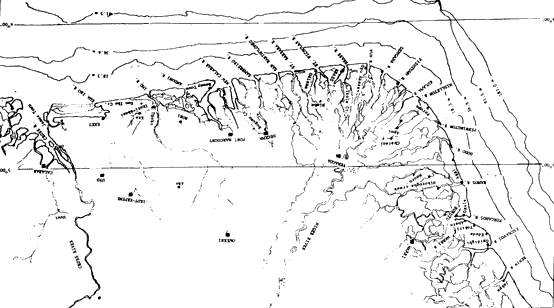
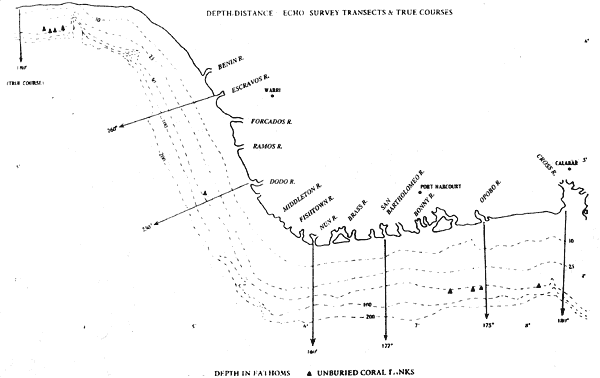
Some of the other coastal characteristics which are of importance to the Nigerian inshore demersal fisheries are the presence of thirty-six estuaries (Amadi, 1990) and the prominent Niger delta, which provides suitable habitat for the penaeid shrimps, finfish and other living marine resources. Hydrographically, the temperatures are generally above 25°C down to 50-m depth and there exists a permanent thermocline, which acts as a natural barrier to the vertical distribution of fish down to 30-40 m with a lower limit of 50-60 m. Salinities range in the area off Lagos from 34‰ from the surface to 50 m depth to about 30‰ off the S. Eastern coast extended down to 30 m where freshwater run off influence the shelf water. The oxygen content is rich steadily decreasing with depth down to 400 m (Amadi, 1982).
Various efforts have been made in the past four decades by the Nigerian Institute
of Oceanography and Marine Research (NIOMR) and others to survey the marine
resources and estimate the potential yields for the inshore marine fish and
shrimp resources. The exploratory Guinea Trawling survey conducted during 1963
and 1964 between 15-50 m depth evaluated the biomass of the central portion
of the Nigerian continental shelf and the entire shelf area as 21 100 MT and
351 000 MT respectively (Williams, 19968). Based on experimental trawls during
the 1962-1963 inshore resource survey, Longhurst (1969) predicted that the potential
yield of sciaenid community was 11 000 MT, which could increase to 141 500 MT
when the sub-thermocline sparid community was included. Longhurst (1969) reported
that: Penaeus notialis (duorarum) and Parapenaeopsis atlantica occur abundantly
off the Niger delta between 27-45 m and 9-27 m depths respectively.
Raitt and Niven (1965 - 1969) confirmed the potential and identified four areas
of exceptionally high catch rates with off-peak catch rates of 24-51 kg/hr head-on
which were higher than the break- even value of 19 kg/hr head-on recorded by
Bayagbona et al, in 1971. Even though shrimping could be undertaken all year
round, June and December featured the highest catch rates. FAO (1969) carried
out surveys in the Western and Mid-Western regions, which concentrated on Penaeus
notialis and estimated potential yield of 2 500 MT. Some attention was paid
to the clupeids too. Bayagbona (1979) analysed 1971-1978 catch and effort data
and estimated the MSY of P. notialis and Parapenaeopsis atlantica as 245 MT
and 904 MT respectively. By 1973, the annual potential of penaeid shrimps was
estimated to be between 3 500 and 4 000 tonnes (Ajayi, 1991).
With the acquisition of more vessels of higher research capacities for marine fish resources survey, NIOMR was able to intensify the implementation of the fisheries resources programme and consequently Tobor (1991) reported the estimated yield potentials of inshore waters 0-50 m. Offshore demersal and pelagic resources are reported to be 16 620 MT, 6 730 MT and 9 460 MT respectively. Deeper water surveys have also indicated some fisheries resources, which have economic potentials. These include: Tunas, whose potential yield was estimated in 1982 and 1983 at about 10 000 per annum and driftfishes, Arioma bondi, A melanum with catch rates of 63-160 kg/hr between 140-250 m depth off the mouths of Benin, Escravos, Forcados and Sambreiro Rivers, deeper water shrimps - Plesipenaeus edwardsianus and lobsters - Neobarriotta pinnata (40 m - 600 m depth). A major obstacle to the tuna exploitation was the lack of tuna baitfish. NIOMR has carried out a survey in which anchovy was found but commercial investment in the fishery is yet to commence. R/V DR. Fridtjof Nansen trawling survey of 1981 confirmed the occurrence of sparids between 50 m - 200-m depth. The catch rates in kg/hr of the important species in the surveyed area included:
| Species | kg/h |
| Priacanthus arentus | 21.9 |
| Arioma bondi | 6.8 |
| Dentex angiolensis | 6.3 |
| D. Congolensis | 5.1 |
| Spicara alta | 4.1 |
| Trichiurus lepturus | 2.8 |
| Brachydeuterus auritus | 1.7 |
| Squatina aulata | 1.9 |
| Epinephelus aeneus | 2.0 |
| Shrimp | 5.3 |
| Cephalopods | 1.9 |
The industrial inshore fisheries sub-sector. The Nigerian industrial inshore
fishing activities consist of trawling for demersal finfish and shellfish, principally
penaeid shrimps. The finfish species are heterogeneous and occur down to 50-m
depth. They belong to supra-thermocline and sub-thermocline communities. Tobor
(1965-1968) recorded 71 families comprising 157 species most of which are small
in size. But the major target families/species of the supra-thermocline community
(i.e. sciaenids) include:
- Sciaenidae, (croakers), Pseudotolithus typus, P. senegensis, P. elongatus
and P. brachynathus (4 species).
- Cynoglossidae (Tongue Sole), Cynoglossus senegalensis, C. Canariensis, C.
mondi and C. browni.
- Ariidae (Catfish), Arius heudeloti, A. gigas, A.Latiscutatus, A. parki.
- Polynemidae (Shrinynose or Threadfins), Polydactylus quadrifilis, Galeoides
decadactylus.
- Haemulidae (Grunters); Pomadasys jubelini, P. suillus; P. incisus, P. peroteti.
- Sphyraenidae (barracudas), Sphyraena barracuda, S. afra, S. guachancho.
- Carangidae (Jack fish), Caranx hippos, C. crysos, C. latus, C. lugubris.
Other sciaenids, which occur in Nigeria waters, include the bigeye grunt (Brachydeuterus auritus) and moonfish, (Vomer setapinnis). Some of these fish species are also genetically undersized including the members of the prominent pelagic family Clupeidae such as Sardinella spp. which are fished intensively by the artisanal sector. The sparid community comprises y2859ely the following major families/species: - Lutjanidae (Red snappers) - Lutjanus goreensis L. fulgens, L. agennes and L. dentatus, and serranidae (Groupers), Epinephelus aeneus. Other sparid family/species found in Nigerian waters are the Sparidae, Dentex canariaensis, D. angolensis, D. congoensis (down to 50 m depth and below), and the breams e.g. Pagrus Sp. Pagellus coupei and Pagus sp. down to 170-m depth and below. The commercial penaeid shrimps being exploited in the Nigerian coastal waters predominantly inhabit the soft mud substrate of the Niger Delta and eastwards to Cross River. They occur too in Lagos West Grounds. Their order of importance in the inshore shrimp fishery of Nigeria is:
- Panaeus notialis (White prawn) down 27 m to 45 m)
- Parapenaeopsis atlantica (Brown (or Guinea) shrimp) down 9 m - 27 m)
- Parapenaus longirostris (Rose or Red deep water shrimp) down 150 m - 200 m)
- Penaeus krathurus (Striped or tiger shrimp).
- Palaemonidae, Nematopalaemon hastatus (Estuarine prawn) also occur in the
Nigeria waters but are mostly exploited by the small-scale fishermen.
The artisanal coastal fisheries. The artisanal marine fisheries can be categorised into:
- Brackish water or estuarine canoe fishery operating in lagoons, creeks and
estuarines.
- The coastal canoe fishery operates usually within the 5 nm non-trawling zone
but due to motorization and targeted stocks some of the operators may venture
farther into the sea. They lose a lot of fishing days to inclement weather and
scarcity of production inputs etc.
- The artisanal group which y2859ely targets sharks and operates deep into the
sea, deploying drift nets for sharks, sail fishes and saw fishes.
The small-scale fishermen operate dug-out or improved canoes and they are 2
to 10 men on board according to the type of fishery engaged in. Most fish caught
belongs to the sciaenid community including croakers and bonga, shad, catfish,
sardines, soles, shinynose, etc. Polydaclylus spp. (Polynemidae) as well as
members of the Sphraenidae, Lutjanidae, Elopidae, Serranidae, and Carangidae
families. The small-scale fishermen also catch sharks, sail/saw fishes as well
as penaeid, palaemonid, and carid shrimps. They exploit mostly the same with
motorized fishing vessels known locally as "Motor Fishing Vessels"
which are licensed to trawl for fish.
FAO (1969) conducted a comprehensive survey of the coastal and estuarine fisheries
of Western Nigeria fisheries covering about 6 400 km. Of the 91 203 fishermen
estimated, 54.32% were full time. Sentongo, et al., (1983) put the coastal fishermen
population at about 149 000. Between 1990 and 1997 the coastal artisanal fisheries
structure and production were (Table 3 below):
Year |
No of canoes |
% motorised |
Part-time |
Full-time |
Total Nos. |
Fish Production (MT) |
1990 |
76,891 |
20.38 |
190,900 |
261,287 |
452,187 |
170,459 |
1991 |
77,093 |
20.79 |
190,958 |
264,144 |
457,102 |
681,211 |
1992 |
77,076 |
20.81 |
194,016 |
265,831 |
459,847 |
841,407 |
1993 |
77,050 |
20.82 |
192,624 |
263,757 |
456,381 |
106,276 |
1994 |
77,073 |
20.8 |
193,198 |
264,577 |
457,775 |
124,117 |
1995 |
77,067 |
20.81 |
263,919 |
192,739 |
456,658 |
159,201 |
1996 |
77,071 |
20.80 |
264,446 |
193,107 |
457,553 |
138,274 |
1997 |
77,036 |
20.83 |
264,506 |
133,134 |
397,640 |
152,212 |
The Table above makes the catch per fisherman amounting between 1990 - 1997 to 0.378 MT, 0.367 MT, 0.40 MT, 0.23 MT, 0.27 MT, 0.349 MT, 0.303 MT and 0.383 MT respectively. Scott (1966) showed an average catch per fisherman in the coastal and brackish waters of the Niger delta to be 0.60 MT per annum. A baseline survey conducted under the IFAD project in 1992-1993 showed a mean landing of 25.92 MT year for a gauge fishing unit (GFU) in the South-eastern states of Rivers, Akwa Ibom and Cross River (Moses, 1994). The fish production levels attained between 1976 and 1984 are attributable to the fisheries policy of Government in that period which featured assistance to artisanal fishermen under packaged programmes.
Socio-Economic status of artisanal sector. The artisanal fishermen live in temporary or permanent fishing settlements along the creeks, lagoons and beaches throughout the coastline of the country. Majority of settlements is relatively little known but some seem comparatively prosperous in certain very productive areas of Lagos, Ogun, Ondo, Delta, Bayelsa, Rivers, Akwa Ibom and Cross River States. The population of the settlements could range from as low as 50 to areas as high as 10 000. The result of a comprehensive study carried out in 1982 showed that over 50% of the population in the coastal states are within 20-40 years age bracket. The general features of most of these rural fishing settlements are difficulty of access, lack of or inadequate functional social infrastructure such as landing jetties, cold storage facilities, schools, medical or health facilities, water and electricity supplies, etc. Majority of the household members engage in fishing while others are traders, students, artisans, public service or private employees. Some of the household members are unemployed. The standard of living is generally low relative to the other non-fishing communities and reflect an abject poverty not befitting a virile population that produced about 32.5%, 39.4%, 46 %, 50.3%, 40.7% and 40.5% of Nigerian fish supply by all sectors (including fish importation) from 1992 to 1997 (source: Fed. Dept. of Fisheries). The capital formation shows stock components valued at between N 62 000.00 and N 310 000 per GFU (Moses, 1994). These include boats, outboard engine and fishing gear in very active fishing areas. These fishing inputs are either modern in terms of fibre-glass boats of 6-18 m LOA, outboard motors (8HP-40HP) and synthetic nets or could be obsolete non-motorised dug-out canoes with paddles, hooks and lines, etc. In the coastal areas, fishing activities take place on daily basis but are strongly subjected to the vagaries of the weather and season. Productivity relates to the intensity of fishing activities, proximity of fishing grounds and ready availability of suitable fishing, inputs. The significant decline in fishing production by the artisanal sector (coastal and brackish water) from 246 784 in 1984 to 138 274 in 1996 and 1997 was attributed largely to inhibitive cost of fishing inputs, and scarcity as well as sharp upward adjustment of prices of petroleum products, etc. in the Post-SAP era. There has been Government intervention in the area of poverty alleviation and through the implementation of local and internationally supported artisanal fisheries development programmes. Efforts have been made to disburse loans to small-scale fishermen for a procurement of fishing input under the International Fund for Agricultural Development (IFAD) and economic Community of West African States (ECOWAS) assistance programme. However, both assistance schemes cover only a negligible proportion of the artisanal fishermen in four coastal and seven inland states to the tune of N 40.5 millions and N 13 millions respectively (Source: C.B.N. Report, 1994. Actual exchange rate: US$1 = ~90 N). The future prospects for artisanal marine fisheries development are bright because of the priority attention being accorded to Agriculture, including the fisheries sector under the present civilian Administration.
Fisheries share in the Gross Domestic Product (GDP). The aggregate output of the Nigerian economy measured by the GDP at 1984 factor cost grew by 2.4% compared with the increase of 3.2% and 3.4%. In 1996 and 1997, the slight growth in aggregate output is attributed to the resilience of the agricultural sector, among other factors, and the lower growth in production compared with 1996 and 1997 is attributed to high costs of production inputs, persistent shortages of fuel, etc. The share of agricultural production comprising Crops, Livestock, Forestry and Fishing amounted to N 45.61 billion or 40.4% of GDP compared with the respective ratio of 39.4% and 39.0% in 1996 and 1997. At 105.7 (1984 = 100), the index of fish production rose by 6.2% compared with 11.3% in 1997. Fishing contributed N 1.2b, N 1.23b, N 1.48b, N 1.65b, and N 1.88b respectively to the GDP in 1994, 1995, 1996, 1997 and 1998, placing it third among the four sub-sectors of Agriculture since 1996 ahead of Forestry. Many inhibiting factors contributed to the reduction in the rate of growth of fish production. These include the acute shortage and escalation in the costs of vital fish production inputs such as diesel oil (AGO) which hindered shrimp and fish exploitation efforts. In addition, the communal clashes in the Niger delta and the high incidence of sea piracy compounded the problem of the sub-sector by reducing access to fishing grounds. Table 4 below shows the share of the Agricultural sector in the GDP for 1998:
N (billion) | |||||
Activity Sector |
1994 |
1995 |
1996 |
1997 |
1998 |
1 Agriculture (crop production) |
31.04 |
32.09 |
33.31 |
34.74 |
36.46 |
2 Livestock |
5.22 |
5.44 |
5.60 |
5.74 |
5.89 |
3 Forestry |
1.32 |
1.35 |
1.36 |
1.37 |
1.38 |
4 Fishing |
1.12 |
1.23 |
1.48 |
1.65 |
1.88 |
Vessel, gear and accessories characteristics
The Sea Fisheries (Licensing) Regulations of 1992 provide that a Shrimping vessel shall not exceed 23.2 m LOA and 130 GRT, while a Fishing vessel shall not exceed 25.3 m LOA and 150 GRT.
The typical specifications of a shrimp trawler are:
| Length over All (LOA) | - 23.20 m - 24.62 m |
| Breadth | - 5.8 - 7.5 m |
| Depth Moulded | - 3.4 - 4.2 m |
| Draft | - 2.9 - 4.5 m |
| Cruising speed | - At least 10 knots/hr |
| Towing speed | - 2.5 - 3.0 knots/hr |
| Average Engine Power | - y2859e 450 HP - 800 HP; Auxiliary 80 HP |
| Fish finding equipment | - Echo-sounder of vertical type |
| Navigational Aids | - Compass, Decca-navigator/Radios SSB UHF Satellite Navigators |
| Refrigerated fish hold | - About 60 tonnes at - 25°C |
| Fuel Tank | - 50 - 80 MT |
| Fresh Water Tank | - 15 Cubic Meters |
| Voyage days | - 25 - 45 |
| Plate Freezer Temperature/Capacity | - About 0.5 MT/hr at - 30°C - Freezing within 4 hours |
| Accommodation | - 11-13 crew member (Nigerian/Foreign) |
| Outriggers/Boom Vessel | - Galvanised steel material at fore part behind wheel house |
The figure 3 is a technical sketches of a shrimp trawler with outriggers showing the general arrangement of the vessel, the two shrimp trawls and a try net. It is worth mentioning that the motorized vessels operating in coastal areas locally known as "Motor Fishing Vessels" have been arranged and equiped to meet the international standard of shrimp production and processing facilities.
As far as the shrimp trawl are concerned, the netting material is either polythylene (PE) or polypropylene (PP) and meshsize in all trawl sections, apart in the codends, is between 51 mm and 55 mm. The twine diameter is around 1.4 - 1.6 mm in all sections except coden with 1.9 mm and more, of diamond mesh type. The legal codend meshsizes for the fish trawl net and shrimp trawl net are 76 mm and 44 mm stretched respectively. The technical sketche of a typical shrimp trawl net is given in figure 4.
The otter boards are not uniform in weight and dimension. Dimensions are: 2.00 - 4.00 m in length and 1.00 - 2.00 m in hight; the weight is 200 kg - 270 kg; the backstrops are about 4.5 m long made of steel wire ropes of 14 - 16 mm diameter with G-hooks; the pennants are usually 7.00 m long wire rope steel of 14 mm in diameter with G-hooks and recessed links. Shackles 21 - 22 mm are used.
Fishing Efforts/Practices/Crewing
According to the Nigerian Trawler Owners Association (NITOA) sources, about 36 fishing companies presently own 271 Nigerian flag-registered vessels, some of them having been built in USA and Poland. However, not all vessels are operational. Their ownership is either fully Nigerian or joint-ventureship between Nigerians and Foreigners. Government policy currently permits 100% foreign ownership.
The double-rigged/outrigger refrigerated vessels operate day and night using their booms to pull either two or four otter shrimp trawl nets with tickler chains. Turtle Excluder Device (TED) regulation came into force in 1996 to protect the sea turtles. The towing speed is between 2.5-3.0 knots and trawling time is about 3 hours.
The vessels are crewed with about 3 000 foreign and Nigerian crew the later being mostly home - trained Mate certificate holders and 2nd class Engineers. The skippers and chief engineers are mostly Asian and Ghanaian nationals.
In 1999, 31 vessels were licensed to trawl for fish and 187 for shrimps, a considerable drop from the total of 306 vessels licensed in 1997 (266 of which were to trawl for shrimps). This drop is attributable to ageing, non-operational vessels, the withdrawal of most of the 13 m LOA medium-sized vessels from operation and the 1999 licence fee of N 120 000/year for each shrimp trawler above 20 GRT. The Licensing pattern showed a significant shift from fishing to shrimping in the post-SAP (Structural Adjustment Programme) era of 1986 when inshore shrimping vessels rose in number from 54 to 132 in 1988. The change was induced by the desire of investors to earn highly value foreign exchange through shrimp exportation; but this puts the shrimp resources under more severe pressure.
Early attempts at fishing in the inshore waters of Nigeria commenced in the mid 1950's. There had had at that time only some preliminary resources exploratory surveys and inadequate stock assessment studies which could have ensured the sustainability of the trawl fisheries. The knowledge of fishing ground, appropriate craft and gear was also scanty. By 1960, there was some improvement and first intensive fishing commenced on the Lagos West grounds (i.e. Coition - Elk) with the use of bottom trawls with 40 mm meshsize in the codend (Longhurst;1961). However, by 1964 there were indications of over fishing. Bayagbona (1965) analysed 1959-1963 catches of the Lagos based fleet and estimated the maximum sustainable yield of 1 036 MT on estimated annual effort of 90 x 10 horsepower hours. But Longhurst (1964) recorded the actual annual landing of the fleet to be 3,500 MT. The eventual collapse of the fisheries of the area led to decide the closure of the fishing grounds (Sea Fisheries Decree No 30 of 1971). It is pertinent to note that after over two decades of non-trawling on these grounds, the national research institution, NIOMR, pointed out the recovery of the marine fisheries resources in the area. The Sea Fisheries Decree No 71 of 1992 now permits fishing under licence in the Lagos West grounds.
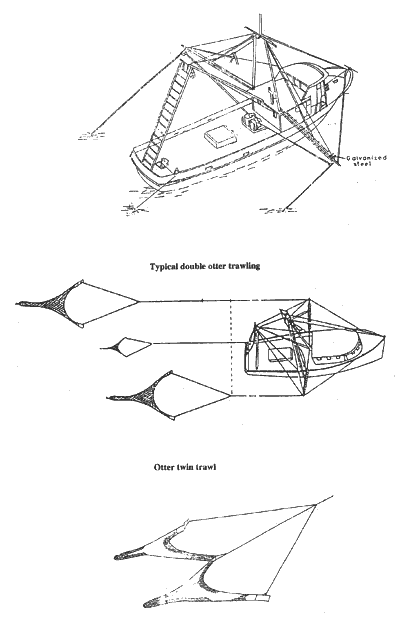
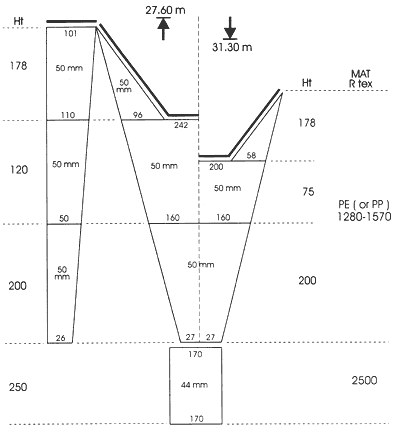
Trawling for shrimps assumed greater importance in the immediate post-SAP era of the mid 1980's. The most prominent penaeid shrimp target was Penaeus notialis commonly referred to as white prawn in Nigeria. Other peaneid targets are Parapenaeosis atlantica (brown shrimp); Parapenaeus longirostris (Deeper water Rose or Red shrimp); Penaeus kerathurus (striped or tiger shrimp).
Tables 5 and 6 show the catch statistics for shrimps and fish between 1985 and 1997 (source: FDF). Initially, the quality of landed shrimps in terms of size used to be very high. The white prawns used to be graded 0-8 with zero being the jumbo size and most expensive while 8 size was the least in value. Grades 5-7 constitute the bulk of the white prawn catch presently. The brown shrimp is assuming greater proportion of landings particularly in the dry season, while the other penaeid shrimps are being intensively exploited, the deeper water shrimps, P. longirostris are yet to be commercially exploited. Sequel to the shift from trawling for fish to trawling for shrimps from 1986 onwards, the pressure on the penaeid shrimp fishery intensified. Thus, the annual catch of the shrimps was, between 1992 and 1997 more than 9,000 (up to more than 12,000 MT) despite the MSY estimated to be between 3 500 MT and 4 000 MT. The total shrimp export to Europe in 1998 was 8 300 MT. This calls for the continuous assessment of the yield potential of panaeid shrimp stocks using more accurate catch and effort data, more so, when the indications are that the Nigerian trawl shrimp industrialists still appear to be favourably disposed to further investment in the shrimp trawling business.

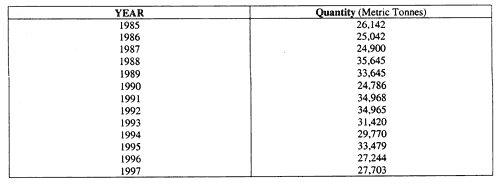
The present data shows that the annual shrimp catch per vessel has not been stable and that between mid-1980's and 1990 there was a sharp drop in the catch per unit effort - See table 7. However there has been an observed increase from 1991 which appears to be levelling out.


The deduction from this CPUE must be taken cautiously because of the level of reliability of the data bases, the unknown actual number of actively shrimping vessels and tile fact that even though some vessels were licensed to trawl for shrimps in the period under focus, their usage of trawl nets with under 44 mm stretched cod-ends would imply that they were engaged in trawling for shrimp not fish. Therefore, there should be no hasty conclusion about the situation of the Nigeria's inshore shrimp fishery. Quite recently but between December and March some surveys were undertaken at some popular fishing grounds at 0-50 m. Data gathered during the research exercise (sometimes at depths above the regulated 18-m depth) using a commercial vessel was analysed and catch in Kilogramme per hour of trawling (kg/hr) used in calculating the catch per unit effort (CPUE). It varies from one fishing ground to the other depending on the season, during movement of the target species, nature of the bottom sediment, abundance resources and other environmental factors. The CPUE calculated at various depths for some popular fishing grounds along the entire continental shelf between 16-22 m depth is shown in table 8 and 9.

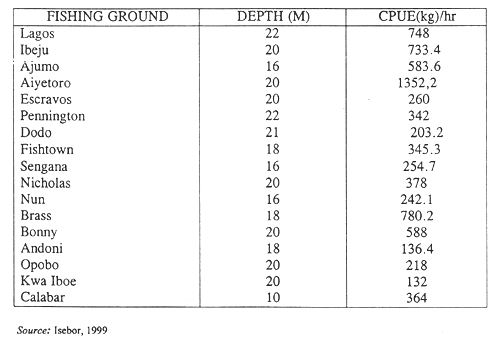
It is observable that grades 0-4 of white prawns, Penaeus notialis that fetch higher prices in the export market have become scarce in shrimp landings. A factor, which perhaps dictates the target of the domestics trawl shrimp fishery, is the current demand of the foreign market and the location of the domestic producer's buyer. A decade back when American and Japanese markets were more patronised, the targets were y2859ely P. notialis which were then semi-processed. Presently, products are mostly exported freshly deep-frozen, head-on, whole or headless, peeled-undeveined (PUD) and decapitated. The y2859e focus is presently on brown shrimps caught in shallower waters with the implication of greater encounter of shrimp trawlers on grounds where small-sized fish species are more abundant. Hence, as a whole, the impact of shrimp trawling fisheries on juvenile fish and other benthic communities is now greater.
Past and present studies confirm the importance of fish bycatches, their species/size composition, discards and mode of utilisation of the bycatch which kept on board when trawling for penaid shrimps in the Nigerian waters which have a multi-species fisheries regime. The occurrence of small but mature fish species in the penaid trawling grounds makes a selection within the fishing gear rather difficult. Even though, trawling for shrimps within the first five nautical miles of the Nigerian continental shelf and in waters shallower than 18 m are prohibited and the codend of a shrimp trawl should have more than 44 mm meshsize, yet observations of fish landings and activities at sea suggest that these statutory provisions of the fishing regulations are not being strictly complied with.
On board vessels, after the trawl net is hauled, its codend is opened and washing/sorting/grading of products into various categories are quickly undertaken. The sorted fish are sealed in 20-kg bags and placed in the refrigerated fish hold at about - 25°C. Similarly the shrimps are packaged in 2.2 kg packets and quickly frozen in batches in the plate freezers on the deck at - 30°C within 4 hours before being stowed in the fish hold in master cartons. Those earmarked for peeling are bagged. The fish by-catch of target species and incidental catches of non-target species is found to be of considerable quantity: 60 to 90 kg per day were reported. The by-catch problem has been immensely compounded by the concentration of the shrimp trawl industry presently on brown shrimps (Caricari) at grounds, which would appear to be the nursery ground of young and juvenile fish. It is common to see several canoes going after fishing trawlers for the sake of discards.
Ajayi and Adetayo (1982) carried out several exploratory trawl hauls between November 1980 and March 1981 working alongside commercial boats in the Niger delta area. They analysed the species composition of the catch and other data, contrasted these with the catch and effort data gathered by FDF since 1970 from the industrial fishing fleet and determined the species composition of the fish discarded as indicated in Table 11.
Visits to coastal fishing villages and general interaction with small-scale fishermen confirm that fishing inputs are very expensive and beyond the revenues of fishermen. Otobotokere (1999) recently reported evidence of sale of discards estimated at about 3 MT daily. The species and size ranges of sampled fish by-catch sold into riverine local markets are shown in Table 11. The average adult length and size at maturity of these fishes indicate that a fairly large quantity of them are removed before reaching maturity and this is bound to have adverse consequences on recruitment. Also there are indications from the Gulf of Guinea Large Marine Ecosystem survey carried out between February and March (1999) of a severe impact of shrimp trawling fisheries on the juvenile of commercial finfish resources. About 90% of the fish by-catch were said to be juvenile and small sized fish. The results of a recent study of the fish by-catch problem at various depths of some popular fishing grounds in Nigeria confirm again that there are high percentages of by-catches accompanying penaeid shrimping in Nigeria. The catch composition varies from one fishing ground to another depending on the targeted species. See Tables 12 and 13, which indicate species and percentage composition on various fishing grounds. Akande (1997) also reported the ratio of shrimp to by-catch based on the catch data of commercial vessels between 1992 and 1997. See Tables 14 and 15. Some naturally small sized fish species were observed to constitute more than 70% of catch at some grounds. Furthermore, an attempt has been made to quantify the juvenile or slow growing fish by-catch through interviews held with some crew members: 10-15 bags of 6 kg juvenile fish are said to be caught daily when targeting brown shrimps and 5-7 bags of 6 kg when targeting white prawns. The commercial value of this trash fish is not high but it contributes to the domestic fish market as food fish and raw materials for the fast food industry. Notwithstanding the lower commercial value of non-target small sized fish species, the large quantity of juvenile of commercial species is a serious concern for biological diversity and sustainability of the shrimp trawling fisheries. The estimate based on the assumption of three and four trips per annum for white prawns and brown shrimps respectively is that about 3 000 MT/year of trash, juvenile and non-commercial fish species may be caught annually by 200 actively operating vessels (Olaniyi, 1999).
Apart from finfish, non-fish species are also caught as by-catch: crabs - Portunus validus (Smooth swim crab. at around 30 m depth) and lobsters - Panulirus regius (5 - 40 m depth);brown Cuttle fish - Sepia officianalis (down to 200 m) and octopus; turtle - Eretmochelys imbricate (Hawksbill), Lepidochelys olivacea (Olive-ridley); molluscs e.g. snails and bivalves;
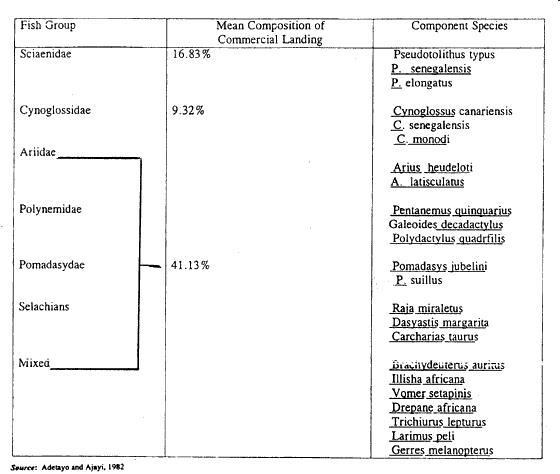

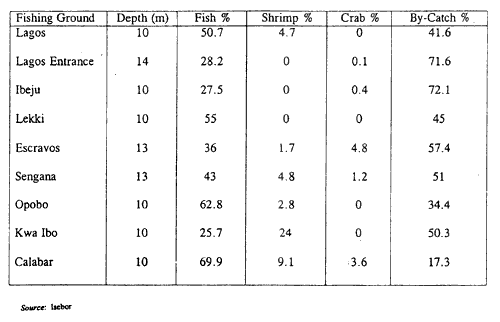

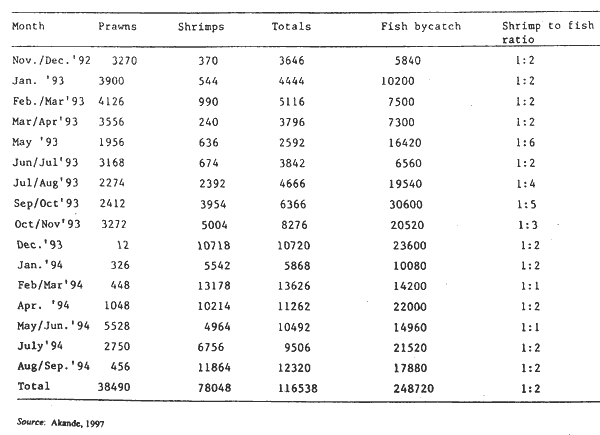
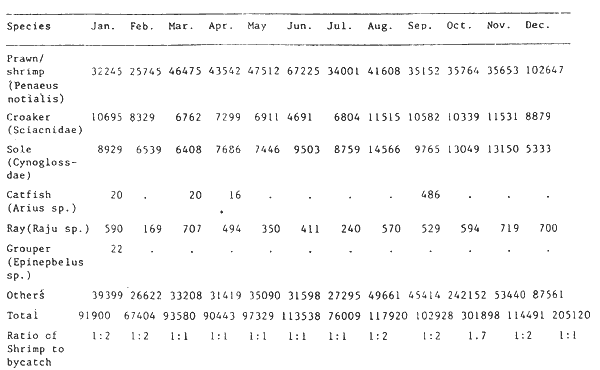
The major markets for the Nigerian shrimp in Europe are Belgium, Portugal, Spain, France and the USA. The semi-processed white Prawns attract higher price (ranging according to sizes 1-7 from US$ 3 - US$ 18/kg) than the peeled, deveined and decapitated brown shrimps sold between US$ 2 and US$ 3. All are usually packaged in 2.2-kg packets into master cartons. The shrimp catches are ususally fairly clean, though they may contain a little bit of debris and mud/sand, which are easily washed on-board the vessel. Out of the 36 operational and active shrimping companies, 14 exported shrimps to Europe in 1998. The total export was 8 028.157 MT valued at 25 865 786.43 US$. Only one company exported processed shrimps, while the others sold them unprocessed. It is worthy to note that fishery products like cuttle fish and crab legs are gradually coming into the export trade though at a marginal level. Fish fillets especially soles (cynoglossidae) were also exported in 1998. Nigeria met the European Union quality standards and is therefore authorized to export shrimps to Europe. Since then, shrimp export has become better organised and it is safe to say that no product from Nigeria has been rejected in the international market as before the introduction of international standards. The Federal Department of Fisheries as the "Competent Authority" to certify shrimps for export has worked hard to ensure that shrimp and other fishery products meet the above mentioned standards.
Nigeria's efforts to ensure responsible inshore fishing practices and proper management of the living marine fish and shell fish resources date back to 1971 when the first comprehensive marine fisheries legislation came into force under the Sea Fisheries Decree No 30 of 1971. In order to further promote the sustainability of the inshore fisheries and the fisheries of the Exclusive Economic Zone of Nigeria, the old decree was repealed in 1992 and replaced by the Sea Fisheries Decree No 71 of 1992. The y2859e Decree contains the general provisions for the conditions for issue of "Motor Fishing Vessel Licences", duties and powers of Authorised Persons and penalties for offences committed under it. The supplements of the Decree namely "The Sea Fisheries (Fishing) Regulations" and the "Sea Fisheries (Licensing) Regulations" contain specific provisions which guide and control investment in industrial marine fishing business and mode of operating such a venture in Nigeria. The current sea fisheries licensing and fishing regulations which impact on shrimp trawling, its by-catch and discard are:
The issue of closed areas and/or season is major concernfor the stakeholders in the Nigerian Shrimp trawling industry and the fisheries authority. Researches are being intensified in order that concrete decisions are based on scientific knowledges and evidence. There are periodic meetings among the members of Nigerian Trawler Owners Association, the Federal Deptment of Fisheries, the Nigeria Institute of Oceanography and Marine Research (NIOMR) and all other fisheries law enforcement agents i.e. the Nigerian Navy, The Marine Dept. of Nigeria Police, Nigerian Customs Service, surveyors or examiners appointed under the provisions of the Merchant Shipping Act. At these consultative fora, matters relating to legislation or any issue of interest to the inshore fishing industry, such as the management of the finite marine fisheries resources are exhaustively deliberated upon.
Constraints to better participation of stakeholders in the management of resources y2859ely relate to the fear of profit loss through perceived reduction in catches when gears with better selectivity are used. The lack of basic, essential, infrastructures on landing places or harbour to fulfil the needs of fishing operators and the generally not too conducive atmosphere may also constitute hindrances to a more co-operative attitude of the industry to the compliance with fishery management measures.
Full knowledge of the behaviour of shrimp in the trawl nets is vital for their successful retention in the codends as shrimps have a tendency to be located near the bottom of the net as the water flow carries them to the codend (Mitchel et al, 1995). Some non-rigid devices such as shrimp/fish separator trawls, use of square meshes in place of diamond-shaped ones at the codends could be further researched. The effectiveness of diamond-shaped 44 mm meshsize now in use for shrimp should be assessed and the consequences of an increase of this meshsize as mandatory should be documented.
The present shrimp exploitation features the concentration of operations of about 200 vessels from Long 5° 00 'E to 8° 30 'E extending down to 80 m isobath at a distance of 7-26 nml from the coast. The most abundant species P. notialis is found between 10-50 m (Dublin-Green and Tobor, 1992). Shrimping voyages take 25-45 days. The intensity of shrimping, as earlier observed, have significantly increased in the past twelve years. Ajayi and Talabi (1984), stated that, based on a sustainable yield of 3500- 4000 MT of shrimp, the fishery in Nigeria cannot absorb more than 50-60 shrimp trawlers. However, since 1992, over 8 000 are reportedly landed every year. Certainly, the viability and profitability of the commercial shrimping venture particularly in the Niger Delta area and eastwards to Calabar river mouth and particularly the considerable foreign exchange earning capacity of shrimp products at export tend to make the investors thinking that the fishery can absorb more vessels. Caution must be taken, however, to avoid over-capitalisation and possible collapse of the shrimp fishery. Granted the level of reliability of available and published catch and effort statistics, the catches are now increasing but not steadily with the CPUE range of 31.71 MT, 46.1 MT, 40.16 MT and 34.27 MT between 1991 and 1994. In reality, with the use of codends with small meshes, the CPUE range would be 20.88 MT, 33.72 MT, 29.27 MT, 25.93 MT for the same period (Olaniyi, Otobotekere, 1999). With many trawlers scrambling in the same area, in coastal waters, to catch as much as they can, both growth and recruitment over fishing can occur (Pauly, 1980).
Vessels licensed to trawl for shrimps increased from 40 in 1985 to 230 in 1994 with corresponding increase in shrimp catch from 2 376 MT to 7 884 MT. A significant drop in the number of Motor Fishing Vessels licensed to trawl for fish occurred between 1988 and 1994 when 161 and 74 were permitted to fish respectively and, as a result, there was a drop in fish landings from this source. Species landed by shrimping vessels are similar to the landings of fish fishing vessels. The concern is in the sizes of the various fish species landed and the high percentage of the juvenile. The higher proportion of smaller-sized catch is due to the use in the codend of meshes less thanthe authorised 44-mm.
In addition, it is worth mentioning that, among the sciaenidae of tropical West Africa, those from the Niger-delta were found being smaller-sized than elsewhere (Longhurst (1964). This further explains the large quantity of small fish in the landings of shrimping vessels. The overall critical impact of the present exploitation results from the fact that the target penaeid shrimps are found in relatively shallow depths where vessels catch increased quantity of juvenile and genetically undersized fish. This impact could be minimised by:
(a) The strict enforcement of the codend mesh size of 44 mm;
(b) 5 nml non-trawling zone regulations to protect the vulnerable nursery grounds
and small-sized fish species;
(c) The introduction of devices which allow easy escapement of juvenile or undersized
fish.
Non-fish by-catches occasionally occur in the landings of shrimp trawlers.. The concerned species are normally non-targetted and include sea snails, crabs, squids, annelids such as polychaetes and oligochaetes, bivalves, gastropods and cephalopods, e.g. octopus, squids and very scarcely lobsters. Presently most of these products are not of significant economic importance and are mostly discarded except on special request for domestic consumption and when, occasionally, some companies is trying to find export markets, for instance for cephalopods and crab legs. Trawler operators indicate the seasonal occurrence of the molluscs and crabs: Crabs are common between May and October and about 1-1½ MT may be caught on a trip. Molluscs are caught between November and April with 2-3 MT per fishing trip. The impact of shrimp trawling fisheries on these invertebrates is not well documented and full scientific investigation into species composition, quantities, implications for biodiversity and potential value would be necessary.
Outrigger vessels using two or four trawl nets are bound to continuously sweep over the bottom of the sea-bed with the tickler chains stirring up the bottom thus destabilising both the infauna that live buried in the sand or mud and the epifauna which inhabit the surface of the bottom. The constant trawling activities in the shrimping grounds disturb the eggs and larvae growth and population development. Their destruction or destabilisation could have adverse effect on the ecosystem and thereby trigger migration to relatively sheltered or protected areas. The areas in-between underwater oil installations have become comparatively rich fishing/trawling grounds for experienced captains.
It is worth noting that greater impact on living marine resources and the habitat probably result more from oil prospecting and other human activities such as uncontrolled urban and industrial development accompanied by untreated solid waste disposal, filling and dredging activities, pollution, oil-well blow outs, etc. Notwithstanding, more specific research should be carried out on the real impact of trawling for shrimps on bottom habitat and benthic communities.
Perceptions differ among individuals, groups and actual operators in the shrimp trawling industry. Fisheries scientists and development officers perceive imminent dangers to the sustainability of inshore trawling fisheries because of the decline in the average size of the commercial fish which are landed and the increasing quantity of small-sized or juvenile fish in fish by-catches. The gradual replacement of catch of good quality and value fish as in the past by less valued miscellaneous fish (locally referred to as MIX) is a typical, serious, sign of over fishing. However, it appears that as long as investors continue to get handsome returns on their capital investments they believe that all is still well. The obvious shift from fishing to shrimping in the late 1980's by the investors coupled with their current favourable disposition to increasing fishing efforts confirm such position and interest in earning highly valued foreign exchange. Notwithstanding, all parties favour an early introduction of closed areas based on incontrovertible scientific basis to select the area to be closed and duration of closure.
Despite the prohibition of trawling by shrimpers in the 5nml of the territorial waters down to 18 m depth, conflicts are still rampant between industrial and artisanal inshore fishing operators. Thus, the canoe fishermen complain vocally against destruction and towing away of nets, ramming of canoes and threats to their very existence by commercial operators. They perceive shrimp trawling operators as not paying any attention and being, even, harmful to the resources and affecting their fishing rights. Nevertheless, booming fish by-catch marketing transactions, mostly comprising juveniles of commercial species and naturally small-sized adults of various fish species have developed among the coast between canoe and trawler operators. Fish merchants are obviously deeply involved in this business and, according to artisanal fishermen, there would be some smuggling.
The newly created Federal Ministry of Environment (formerly the Federal Environmental Protection Agency-FEPA) associates the problem of impact of shrimp traling fisheries to the compliance with the Code of conduct for responsible fisheries and sustainable practices. Some NGOs exist and show interest in the conservation of National resources, but concentrate more on oil pollution, and other habitat alteration and degradation. In Bayelsa and Delta States, the Niger Delta Wet Land Centre had shown concern over trawlers menace, capture of juvenile fish and dumping of discards at sea. The Friends of the Environment (FOTE) and the Nigerian Conservation Foundation (NCF) perceive fishing as one of the human activities disturbing the ocean ecosystem and reducing biodiversity.
The Government agencies on Fisheries (Research and Development) and Environment have consistently shown concern about the effects of shrimp trawling fisheries on the marine ecosystem and biodiversity. It is perceived that effective regulatory and management measures must be put in place to reduce juvenile by-catches in fishing operations or prevent catching of juveniles altogether and protect nursery grounds, among other things. The prevention of excessive fishing/shrimping in the inshore waters can be achieved by the re-deployment of the Nigerian Industrial fleet to exploit the offshore pelagic and deeper water resources or operate under licence on other rich fishing grounds in the sub-region. These are perceived as possible viable options.
The practical knowledge of By-catch Reduction Device (BRDS) of soft/rigid type is scanty but theoretical knowledge from literature is fair. There is no opposition as such to the use of friendly technologies and devices if loss of valuable shrimp products does not accompany the adoption of such techniques. However, one or two operators are quite open to innovations in gear design and construction with a view to allowing better gear selectivity and escapement of small-sized fish species. Modified nets having 60-70 mm meshsize in the codends were testedfor shrimping trawls and the interviewed skippers using these modified nets confirmed that there is no significant drop in shrimp landings but there is a reduction in juvenile by-catch. It was also observed was some saving in fuel consumption. With the success of this private initiative a multiplier effect within the industry can be expected since other fishermen are usually keen to follow successful experiment.
The effects of introducing more environmentally friendly devices into the shrimp trawling fishery will bear on the gains or losses experienced by various concerned groups or individuals. The possible adjustments include the introduction of bigger codend mesh sizes for fishing nets, installation of By-catch Reduction devices (BRDs) and the enforcement of laws preventing the sale and purchase of certain prohibited sizes of fish and other products. The anticipated consequences/results of such adjustments include a reduction in the landing of juvenile fish and small-sized fish species (which are either sold into coastal rural markets or discarded) and, on medium term, the liquidation of such markets. The immediate reactions of the beneficiaries of such lucrative fish by-catch trade will definitely be negative to any such adjustment. As such, there may be a passive and indirect resistance to change.
Another implication is the possible revenue loss to fishing companies due to an overall reduction in catches and this implies that more fishing efforts will be required to capture economic quantity of shrimps. A successful adjustment to more environmentally friendly practices is bound to protect juveniles of various fish species and the sensitive nursery grounds. Thus, more fish will grow to adult sizes before capture and this will, on medium term, lead to increase of the fish landings, in terms of quantity and value and means of livelihood of the local fishermen and their dependants.
Quite a number of national priority issues require attention in introducing more friendly innovative and adaptable shrimp trawling techniques and practices in Nigeria. Intervention in environmental and socio-economic matters requires scientific and detailed understanding of all pertinent issues to enable the development of strategic options. Such issues cover social, financial, research and development, infrastructure, and cost/benefit analysis, among others. Therefore, some of the priority issues listed below need to be addressed:
More detailed research into the inshore fisheries resources focusing on life history, reproductive cycles, migration pattern, behaviour and the environmental aspect is most desirable before the introduction of any By-catch Reduction Devices or Closed Area. The acceptance of any BRD or closed areas/season in Nigeria would therefore require an action plan featuring the following components:
In order to introduce effective and acceptable techniques and practices to shrimp trawling industry that would reduce fish by-catch and loss of biodiversity, it is necessary to implement a programme of action which should include the under-listed projects:
Aderounmu, A.A. (1997) Nigeria Fisheries with emphasis on Resources, production, controls and fishery products' exports and imports
Ajayi, T.O. and Talabi, S.O. (1984) The potential and strategies for optimum utilisation of the Fisheries Resources of Nigeria. Technical Paper No. 18 Nigerian Institute for Oceanography and rine Research, Lagos
Ajayi, T.O. and Adetayo, J.A. (1982) On the fish by-catches and discard of the Shrimp Fishery of Nigeria. Technical paper No. 5 Nigerian Institute for Oceanography and Marine Research, Lagos
Ajayi T.O. (1982) The maximum sustainable yields of the inshore Continental Shelf. Pp. 571-577 Journal of Fisheries Biology (1982) Vol. 20
Allen, J.R.S. and Wells, J.W. (1962) Holocene coral banks and subsidence in the Niger-Delta
Amadi, A.A. (1982) Species composition, distribution and resource potentials of fishes recorded in bottom trawling between 50-200 m depth off the Nigerian coast
Anetekhai, M.A. (1991) Impact of Tropical Shrimping on Living Resources of the Gulf of Guinea
Bayagbona, E.O. and Ajayi T.O. - Coastal and Inshore Marine Fishery Resources of N.I.O.M.R (1980) Nigeria
Central Bank of Nigeria (1998) Annual report and statement of accounts
Elliott, O.O. (1999) Proposed FAO Project on the reduction of the impact of Tropical Shrimp Trawling Fisheries on Living Marine Resources
FAO (1969) Fisheries Survey of Western and Mid-western Regions of Nigeria
Federal Republic of Nigeria Decree No 71 - Sea Fisheries Decree 1992 Official Gazette No. 71 S.I. 18 - Sea Fisheries (Licensing) Regulation
Vol. 79 (1992) S.I. 19 - Sea Fisheries (Fishing) Regulations Fisheries Statistics of Nigeria, Federal Department of Fisheries Publication. Abuja 3rd Edition (1995)
Isebor, C.E. 1999 Proposed FAO Project on the Reduction of the impact of tropical Shrimp Trawling Fisheries on Living Marine Resources
Moses, B.S. (1994) Baseline survey of catch, catch rate and species composition of the artisanal fisheries of the south-eastern Nigeria
Olaniyi, A.O.A. (1999) Reduction of the impact of Tropical Shrimp Trawling Fisheries on Living y2859ee Resources (By-catch and discards reduction and the Environment)
Otobotekere, A.J.T. (1999) Reduction of impact of Tropical Shrimp Trawling Fish Fisheries on Living Marine Resources. (Project UNO/INT/724/GEF)
Raitt (DIFS) and Niveno, R. (1969) Exploratory prawn trawling of the Niger Delta proc. Symp.Oceanogr.Fish.Res.Top. Abidjan 1966, 403-444
Ssentongo, G.W.; Ajayi, T.O.; Report on a Resource Appraisal of the Artisanal and Ukpe, E.T. (1983) Inshore Fisheries of Nigeria. FAO Field Document 2.FI. DP/NIR/77/001. Rome
Tobor, J.G. and Ajayi, T.O. (1991) Highlights of achievements in the last 30
years by the Nigerian Institute for Oceanography and Marine Research and its
Parent Research Division of the Federal Department of Fisheries, Lagos
Dublin-Green, J.G. Marine Resource and activities in Nigeria. Technical Paper
No. 84 Nigerian Institute for Oceanography and Marine Research, Lagos.
Tobor, J.G. (1991) A Decade (1981-90) of Fisheries Research activities at the Nigerian Institute for Oceanography and Marine Research: Hope for Self sufficiency in Fish Production in Nigeria
Udolisa, R.E.K. (1991) Shrimp Fisheries: information of shrimping Vessels and Gear
Williams, F. (1968) Report of the Guinean trawling Survey Vol. 1